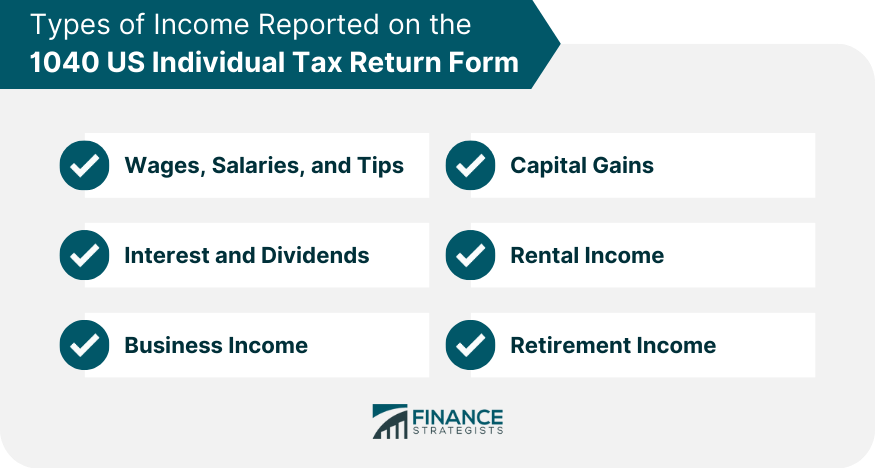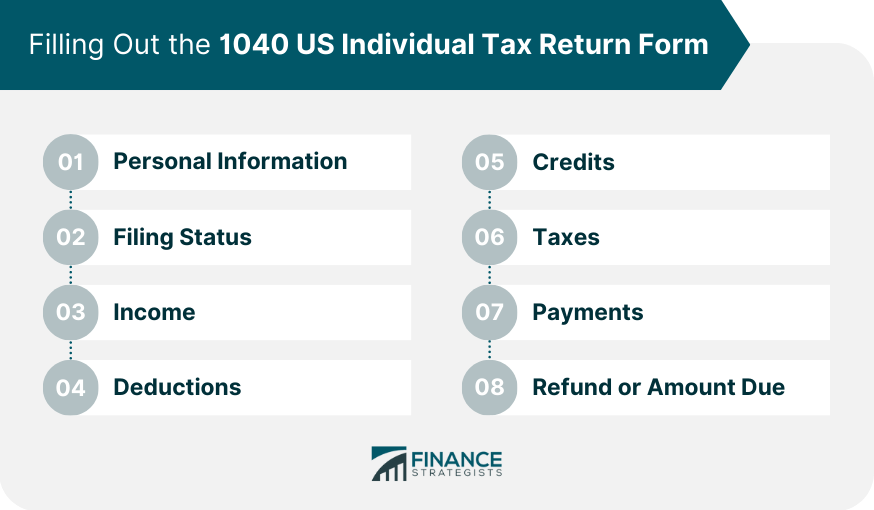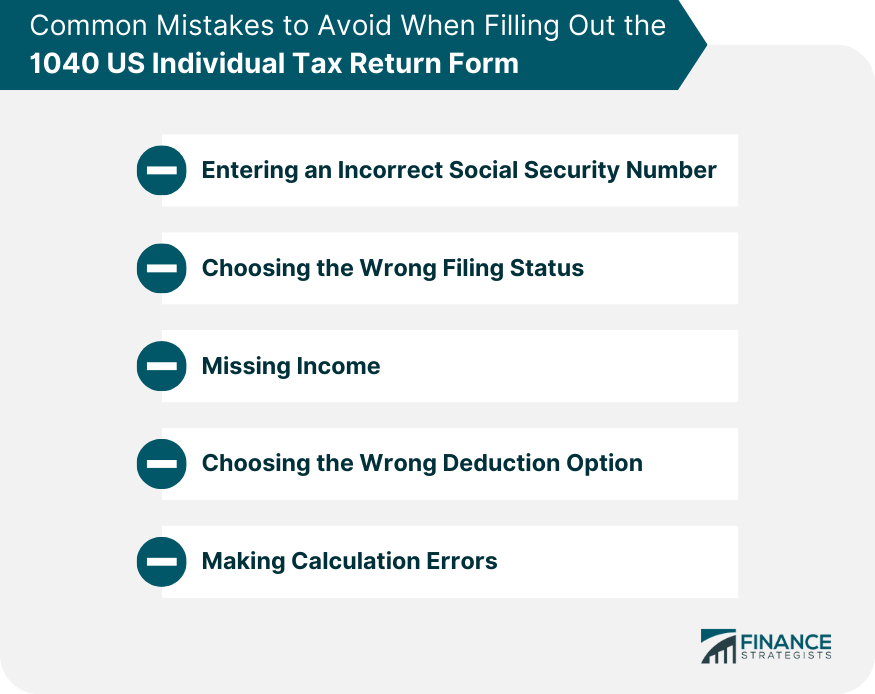The United States Internal Revenue Service (IRS) requires every individual who earns an income to file an annual tax return. The 1040 U.S. Individual Tax Return Form is the standard form used by taxpayers to report their income and deductions to the IRS. Filing taxes is an essential civic duty, and the revenue generated from tax collections is used to fund the federal government's operations, programs, and services. The 1040 U.S. Individual Tax Return Form is required to be filed by every individual who earns an income, whether from wages, salaries, tips, interest, dividends, or any other source. The form is also required for individuals who are self-employed or receive income as an independent contractor. This category refers to income earned from employment. It includes regular wages or salaries received from an employer, as well as any tips received in cash or through an electronic payment platform such as credit card transactions. This category also includes bonuses, severance pay, and other forms of compensation. This category includes income earned from investments such as stocks, bonds, and savings accounts. Interest income is earned on funds deposited in savings accounts or certificates of deposit, while dividend income is earned from owning shares in a corporation. This category refers to income earned from self-employment or owning a business. It includes income earned from a sole proprietorship, partnership, or LLC. Business income can also include rental income received from owning property. This category refers to profits earned from the sale of assets such as stocks, real estate, and other investments. Capital gains can be short-term or long-term, depending on the holding period of the asset. This category refers to income earned from renting out properties. It includes income received from residential rental properties, commercial rental properties, and vacation rentals. This category includes income received from pensions, annuities, and social security benefits. Retirement income can also include distributions from retirement accounts such as 401(k)s and IRAs. This is a fixed deduction amount available to all taxpayers. The standard deduction amount varies depending on the taxpayer's filing status and age. Taxpayers can choose to itemize their deductions instead of taking the standard deduction. Itemized deductions include expenses such as medical expenses, state and local taxes, charitable contributions, and mortgage interest. Taxpayers can claim personal exemptions for themselves and their dependents. However, the personal exemption was suspended in tax years 2018-2025 under the Tax Cuts and Jobs Act (TCJA). Taxpayers can claim tax credits to reduce their tax liability. Tax credits are more beneficial than deductions because they reduce the amount of tax owed directly. This is the standard form used by most taxpayers to report their income and deductions to the IRS. The form is used by taxpayers who are U.S. citizens, permanent residents, or resident aliens. This form is similar to the standard Form 1040 but is specifically designed for taxpayers who are 65 or older. The form has larger font sizes, more prominent sections for reporting retirement income, and a simpler design to make it easier for seniors to file their tax returns. This form is used by nonresident aliens who have earned income in the United States. Nonresident aliens are individuals who are not U.S. citizens or permanent residents and do not meet the substantial presence test. This form is used to amend a previously filed tax return. Taxpayers use this form to correct errors, report additional income or deductions, or claim a refund. This form is used to estimate and pay quarterly taxes on income that is not subject to withholding tax, such as self-employment income, interest, and dividends. Filling out the 1040 U.S. Individual Tax Return Form can be overwhelming for many taxpayers. Here is a step-by-step guide on how to fill out the form: Enter your personal information, including your name, address, and social security number. If you are married filing jointly, you will also need to provide your spouse's name and social security number. Choose your filing status, which can be single, married filing jointly, married filing separately, head of household, or qualifying widow(er). Your filing status will determine your tax rates and the deductions and credits you are eligible for. Report all types of income earned during the tax year, including wages, salaries, and tips; interest and dividends; business income; capital gains; rental income; and retirement income. You will need to attach any necessary forms or schedules to report specific types of income, such as Schedule C for self-employment income or Schedule D for capital gains. Choose either the standard deduction or itemized deductions, and report any other adjustments to income such as IRA contributions, alimony paid, or student loan interest. If you choose to itemize deductions, you will need to attach Schedule A to report specific deductions, such as medical expenses, state and local taxes, and charitable contributions. Claim any tax credits that you are eligible for, such as the earned income tax credit, child tax credit, and education credits. You will need to attach any necessary forms or schedules to claim specific credits, such as Form 8863 for education credits. Calculate your tax liability using the tax tables provided by the IRS or by using tax preparation software. You will need to report any federal income tax withheld by your employer or estimated tax payments made throughout the year. Report any payments made towards your tax liability, including estimated tax payments or tax credits from previous years. Calculate whether you owe additional taxes or are entitled to a refund. If you owe additional taxes, you will need to include a payment with your tax return. If you are entitled to a refund, you can choose to receive it by direct deposit or check. Ensure that you enter your social security number correctly, as an incorrect number can lead to processing delays or errors in tax calculations. Choose the correct filing status to avoid errors in tax calculations. For example, some taxpayers may qualify for head of household status but may mistakenly choose the single filing status. Ensure that you report all types of income earned during the tax year, including wages, salaries, and tips; interest and dividends; business income; capital gains; rental income; and retirement income. Failing to report all income can result in penalties and interest charges from the IRS. Choose the correct deduction option (standard deduction or itemized deductions) and report any other adjustments to income accurately. Choosing the wrong deduction option or reporting incorrect adjustments to income can lead to errors in tax calculations. Double-check all calculations to avoid errors in tax liability calculations. Common calculation errors include entering the wrong amount or using the wrong tax rate. Ensure you save accurate records of all income earned and expenses incurred throughout the year. This can include keeping receipts, invoices, and bank statements. Choose the precise deduction option (standard deduction or itemized deductions) based on your individual situation. If you have significant deductions, such as medical expenses or charitable contributions, itemizing deductions may be more beneficial. These credits can include earned income tax credits, child tax credit, and education credits. Check eligibility requirements carefully and keep all supporting documentation. Contributions to retirement accounts such as 401(k)s or IRAs can reduce your taxable income, which can lower your tax liability. If you are self-employed or own a small business, take advantage of business deductions such as home office expenses, business travel, and equipment expenses. Plan charitable contributions strategically to maximize tax benefits. Consider donating appreciated assets such as stocks or mutual funds to charity to avoid capital gains taxes. Stay informed about tax law changes that could affect your deductions and credits. Tax laws change regularly, and staying informed can help you take advantage of new deductions or credits. The deadline for filing the 1040 U.S. Individual Tax Return Form is April 15th, unless that day falls on a weekend or holiday, in which case the deadline is extended to the next business day. Taxpayers who cannot file their tax return by the deadline can request an extension by filing Form 4868, which provides an additional six months to file. However, an extension to file does not extend the deadline for paying any taxes owed, and interest and penalties may apply to any unpaid balance after the deadline. Failure to file a tax return on time can result in penalties and interest charges from the IRS. The penalty for filing a tax return late is usually 5% of the unpaid taxes per month, up to a maximum of 25% of the total unpaid taxes. The penalty for paying taxes late is usually 0.5% of the unpaid taxes per month, up to a maximum of 25% of the total unpaid taxes. Interest is also charged on any unpaid taxes, currently at a rate of 3% per year, compounded daily. In addition to penalties and interest, taxpayers who fail to file or pay their taxes may also face other consequences, such as a tax lien or levy on their property or wages, seizure of their bank accounts, or legal action by the IRS. Therefore, it is essential for taxpayers to file their tax returns on time and accurately and to pay any taxes owed by the deadline to avoid these negative consequences. Taxpayers who are unable to pay their taxes in full by the deadline can contact the IRS to set up a payment plan or negotiate an offer in compromise, which is a settlement agreement with the IRS to pay less than the full amount owed. In conclusion, the 1040 U.S. Individual Tax Return Form is a crucial document that every individual who earns an income must file annually. The form requires taxpayers to report their income and deductions accurately to the Internal Revenue Service (IRS). Filling out the form can be challenging, but understanding it can help taxpayers maximize their deductions and credits, while avoiding penalties and interest charges. It is vital for taxpayers to ensure that they file their tax returns on time and accurately to avoid any negative consequences. Taxpayers who need further assistance with filing their tax returns can seek help from tax professionals or visit the IRS website for additional resources. The IRS provides several publications, forms, and online tools to assist taxpayers in filing their tax returns correctly and on time. Filing taxes may seem overwhelming, but it is an essential civic duty that funds government programs and services. By understanding the 1040 U.S. Individual Tax Return Form and following the guidelines provided by the IRS, taxpayers can fulfill their obligations while maximizing their deductions and credits.1040 US Individual Tax Return Form: Overview
Types of Income Reported on the 1040 US Individual Tax Return Form
Wages, Salaries, and Tips
Interest and Dividends
Business Income
Capital Gains
Rental Income
Retirement Income

Deductions and Credits Available on the 1040 US Individual Tax Return Form
Standard Deduction
Itemized Deductions
Personal Exemptions
Tax Credits
Different Versions of the 1040 US Individual Tax Return Form
Form 1040
Form 1040-SR
Form 1040-NR
Form 1040-X
Form 1040-ES
Filling Out the 1040 US Individual Tax Return Form
Step 1: Personal Information
Step 2: Filing Status
Step 3: Income
Step 4: Deductions
Step 5: Credits
Step 6: Taxes
Step 7: Payments
Step 8: Refund or Amount Due

Common Mistakes to Avoid When Filling Out the 1040 US Individual Tax Return Form
Entering an Incorrect Social Security Number
Choosing the Wrong Filing Status
Missing Income
Choosing the Wrong Deduction Option
Making Calculation Errors

Tips for Maximizing Deductions and Credits
Keep Accurate Records
Choose the Correct Deduction Option
Claim All Eligible Credits
Contribute to Retirement Accounts
Take Advantage of Business Deductions
Plan for Charitable Contributions
Keep Up With Tax Law Changes
Deadlines and Penalties Related to the 1040 US Individual Tax Return Form
Final Thoughts
1040 US Individual Tax Return Form FAQs
The 1040 U.S. Individual Tax Return Form is the primary form used by individuals to file their federal income tax return in the United States. It is used to report the taxpayer's income, deductions, credits, and tax payments for the year.
The deadline to file the 1040 U.S. Individual Tax Return Form is April 15th of each year, unless it falls on a weekend or holiday, in which case it is moved to the next business day.
Anyone who earned income during the year that exceeds a certain threshold is required to file the 1040 U.S. Individual Tax Return Form. The threshold varies depending on filing status, age, and other factors.
Common mistakes to avoid when filling out the 1040 U.S. Individual Tax Return Form include errors in math, incorrect identification numbers, failing to sign the form, and not reporting all income sources.
Yes, the 1040 U.S. Individual Tax Return Form can be filed electronically using the IRS e-file system or through a tax professional. E-filing can be faster and more secure than filing a paper return.
True Tamplin is a published author, public speaker, CEO of UpDigital, and founder of Finance Strategists.
True is a Certified Educator in Personal Finance (CEPF®), author of The Handy Financial Ratios Guide, a member of the Society for Advancing Business Editing and Writing, contributes to his financial education site, Finance Strategists, and has spoken to various financial communities such as the CFA Institute, as well as university students like his Alma mater, Biola University, where he received a bachelor of science in business and data analytics.
To learn more about True, visit his personal website or view his author profiles on Amazon, Nasdaq and Forbes.















